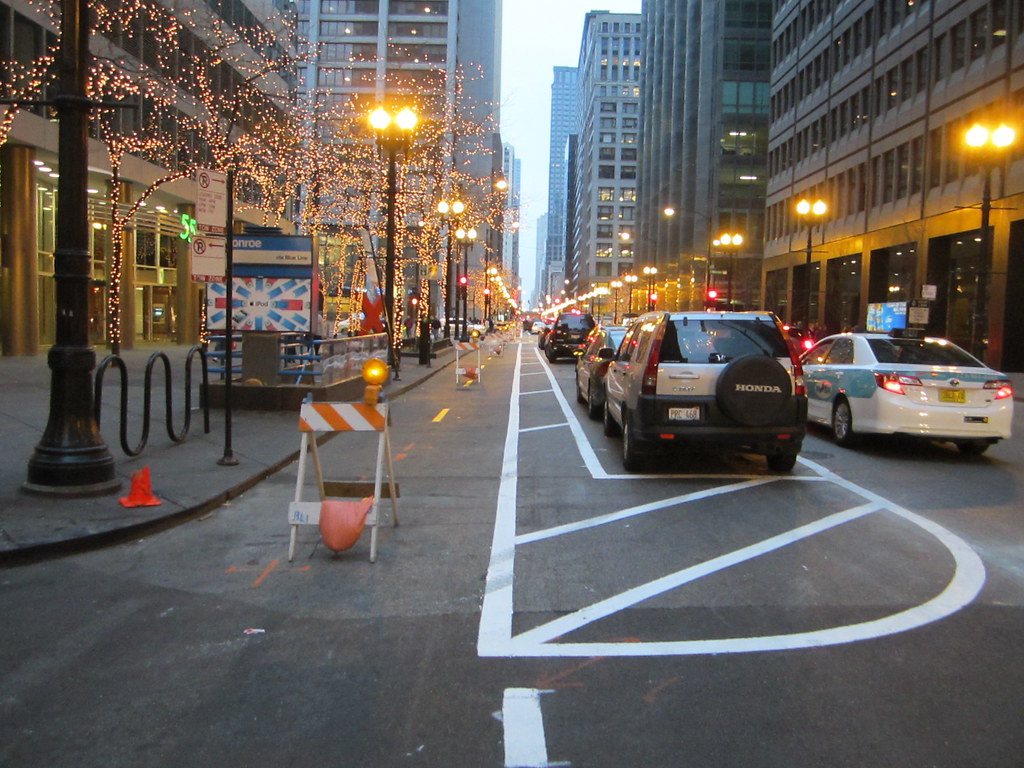Bicycling in San Francisco is getting better since the bicycle injunction was lifted in 2010, and concrete progress on projects like the critical Fell and Oak Street bikeway is very encouraging. But this week also made bicyclists in SF painfully aware that as the SF Municipal Transportation Agency gets closer to completing the projects in its Bike Plan, it will need to elevate its game to keep up with the nation's leading cities. The upcoming release of the SFMTA's Bicycle Strategy is a can't-miss opportunity to pick up the pace.
The latest reminder that SF risks falling far behind the leading American cities came when bike advocates around the country got a look at Chicago's new, protected two-way bike lane on downtown Dearborn Street -- providing a 1.2-mile connection to another protected lane on Kinzie Street. It's part of Chicago Mayor Rahm Emanuel's commitment to building 100 miles of protected lanes within his first four years of office. And it stands in contrast to the much slower roll-out of protected bike lanes, so far, under SF Mayor Ed Lee.
The SFMTA is planning a handful of similar projects on streets like Market, Second, and Polk, and getting improvements like that into the pipeline is hugely important. Still, those improvements are several years off from construction, as part of larger street makeovers. Meanwhile, cities like Chicago and New York are making much more rapid progress toward building continuous protected bike routes into their major job centers.
San Francisco could catch up, depending on the commitments the SFMTA makes in its upcoming Bicycle Strategy, which planners are expected to brief the agency's board on in January. SFMTA staff says the strategy will lay out a network of priority routes for bike improvements that will help attain the city's official goal of increasing bicycling's share of all trips to 20 percent by 2020.
To get San Francisco to its mode-share target, the strategy also has to include solid commitments to building bike infrastructure within a competitive timeframe. "The city is really moving at the pace of several years ago, when really we need to be preparing for a dramatically different San Francisco, where significantly more people are biking," said Leah Shahum, executive director of the SF Bicycle Coalition.
The need for protected bike lanes is increasingly important in downtown areas with high-speed traffic like SoMa, where jobs are growing and bike-share is expected to launch early next year. "As we expect to see more people bicycle thanks to bike-share, and thanks to more businesses, especially tech businesses being located in San Francisco, I think we're seeing a real lack of urgency from city agencies about upgrading streets for more and better biking," said Shahum.
Last week, Chicago's Department of Transportation began implementing the two-way protected bike lane on Dearborn, connecting the center of the Chicago Loop to a similar lane on Kinzie Street that was implemented last summer. John Greenfield of Grid Chicago said the Dearborn project, which was announced by the city in August, was done using low-cost methods: re-striping traffic lanes to place the two-way bikeway along the curb, separated from the car parking lane by a striped buffer zone. The lane has bicycle traffic signals at each intersection to allow bicycle riders to travel through the intersection on a dedicated signal phase, eliminating conflicts with turning cars. The current citywide goal, said Greenfield, is 110 miles of protected lanes and 40 miles of buffered lanes by 2015.
"We're really inspired by Rahm Emanuel's leadership and dedication to 100 miles of crosstown bikeways," said Shahum. "The Dearborn bike lane is exactly the kind of project we need in San Francisco. Huge numbers of people bike on Market Street daily, and just like Chicago, we should have a safe, protected bikeway down the center of our city."
San Francisco has seen few similar projects in the downtown area. Market Street has a green, physically separated bike lane, but it only runs from Eighth Street to Octavia Boulevard. Though all of lower Market could get a continuous, raised bike lane as part of the Better Market Street project, that isn't slated for completion until 2016, assuming it doesn't see more delays.
Second Street, meanwhile, was originally slated for conventional bike lanes -- a design that was improved upon after a communication breakdown between agencies forced the planning process to be re-started. Now, planners are proposing raised, protected bike lanes as part of a major street makeover, but it won't be completed until the end of 2015.
These are excellent projects, but it doesn't have to take so long to reconfigure the street.
There's some proof closer to home than Chicago. On one-way Eighth Street in SoMa, the SFMTA created a wide, buffered bike lane in July by re-configuring a traffic lane in conjunction with a street re-paving. It's not an ideal design (motorists frequently drive in it), but Shahum noted that it's an example of "the city taking an advantage of an opportunity to be relatively quick and nimble in changing the lane configuration."
That's a practice bike advocates would like to see more of.
"The city needs to streamline its planning and implementation process, and not get so mired down in a cycle of planning forever with the intent of making everyone happy," Shahum said. "Yes, you do community outreach, and yes, you do good analysis and work with neighbors and merchants. But there are smart ways that you can implement pieces of a plan in an iterative way that helps bring positive change more quickly, costs less, and builds confidence that change can be good."
The impetus for protected bike lanes, which also calm car traffic and make streets safer for all users, was perhaps put best by SFMTA Director of Transportation Ed Reiskin last month at a conference with the National Association of City Transportation Officials in New York.
"The most cost-effective investment we can make in moving people," he said, "is in bicycle infrastructure."





